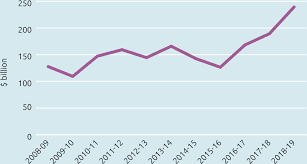In our endeavor to formulate our annual budget, we are meticulously gathering economic data pertinent to Australia's automotive industry. This entails scrutinizing key indicators such as GDP growth, international trade dynamics, and trends in car sales to inform our budget projections effectively within the Australian automotive market.
GDP Growth Rate: Australia's GDP growth rate is pivotal for gauging the country's economic trajectory and its implications for the automotive sector. By examining historical GDP growth rates, we can anticipate economic shifts that may influence consumer spending patterns and overall demand for cars. A robust GDP growth rate may signify increased consumer confidence and purchasing power, thus impacting our budget allocations for production, marketing, and expansion efforts within the Australian automotive market.
International Trade Volume: Australia's participation in international trade significantly influences our budget forecasts for the automotive industry, particularly regarding car imports and exports. Monitoring trade volumes of cars enables us to assess market dynamics, identify potential trade barriers, and adjust our budget strategies accordingly. Fluctuations in trade volumes may affect import tariffs, supply chain costs, and the overall competitiveness of cars in the Australian market.
Car Sales Trends: Analyzing car sales trends in the Australian market is essential for aligning our budget with consumer demand and market trends. By tracking sales data, we can identify emerging preferences, anticipate shifts in consumer behavior (e.g., growing demand for electric vehicles), and allocate resources effectively. Understanding sales trends enables us to tailor our budget strategies to capitalize on growth opportunities and enhance our market presence in Australia's automotive industry.
Explanation of Graphs:
GDP Growth Rate Graph: This graph illustrates Australia's historical GDP growth rates over the past five years, providing insights into the country's economic performance and its potential impact on consumer behavior and car sales trends.
https://www.researchgate.net/figure/Australia-GDP-growth_fig1_318529289
https://www.dfat.gov.au/publications/trade-and-investment/trade-and-investment-glance-2020
Car Sales Trends Graph: This graph presents sales trends for cars in the Australian market, allowing us to identify patterns and shifts in consumer preferences. By analyzing sales data, we can make informed decisions about inventory management, marketing initiatives, and budget allocation strategies to enhance our competitiveness in Australia's automotive industry.
https://www.dinggo.com.au/blog/car-sales-figures-and-statistics-in-australia




No comments:
Post a Comment